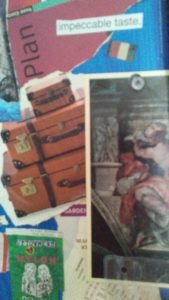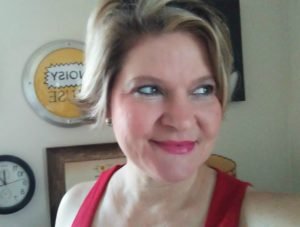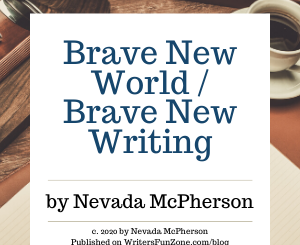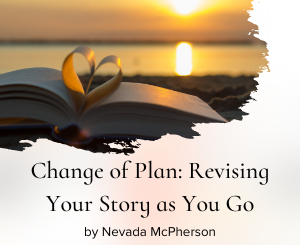Now Boarding! By Nevada McPherson
 Let’s welcome back monthly columnist Nevada McPherson as she shares with us “Now Boarding!” Enjoy!
Let’s welcome back monthly columnist Nevada McPherson as she shares with us “Now Boarding!” Enjoy!
***
A whole new season is on the way and there’s fresh writing to be done. I have projects to begin and projects to complete, but with the fall energy already in the air, it can be difficult to set my mind to any one thing. Sometimes looking at certain images helps me to get inspired.
Visual Learner
I’m a very visual learner and writer and with my background in screenwriting and graphic novels and my love for decoupage and collage, I collect pictures from everywhere for inspiration.
I have a huge postcard collection started back in 1979 when I went on a cross-country road trip with my grandmother, aunt and uncle. I used to have tons (seemed like it) of pictures, fliers, ads and all manner of ephemera featuring all kinds of events, movies, people, objects and the list goes on and on. These lived in boxes and plastic containers in the garage which was also my craft studio at the time.
Since I’ve moved a few times in the last few years, I’ve culled my picture collection down to one or two boxes, and my post card collection down to two boxes, but I still collect pictures and place them all over my workspace: a cover from a magazine here, artwork from a ten year-old calendar there. Sometimes I need visual inspiration for a particular project and that’s when I need a mood board, one of my favorite things to create!
Mood Board
Making a mood board can be lots of fun and they’re a great tool for sparking creativity. Having said that, the making of the mood board itself can take up a lot of your time as you obsessively collect pictures from magazines and other places to set just the right mood for your board.
For this reason I love the advice offered by author/artist/ entrepreneur Jennifer Lee in her book The Right Brain Business Plan, about not allowing yourself much more than an hour to create your mood board. That way you have some visuals to inspire you to take action but the mood board is a means to an end (writing your story), not an end in itself.
In the past, I’ve created mood boards to go with the themes, scenes and settings for my graphic novels, and sometimes I make separate boards for individual characters.
Each of my characters has an individual style, so when I run across a perfect look for one of them in a fashion magazine, I tear out the picture and glue it to the board. Having a collection of images around a theme makes for a quick reference and refreshing flash of inspo.
Word Cloud Board
If you’re all about the words themselves, another idea could be to create your own “word cloud” board, featuring words and phrases in various sizes and fonts. These could be words and phrases related to your stories, characters, genres, or even what your readers are seeking when looking for books to read.
Whatever type of board you create, put it over your desk or someplace in your workspace where you’ll see it every day. When you’re on to the next project, you can just create a new board over that one, or if you want to save the original, keep it as a souvenir of a job well done.
If you ever decide to write a sequel, you can just add new words and images, using the earlier board as a foundation for your new project. It’s fun, and it helps you get your work done. Win-win!
Happy writing!
***
ABOUT THE AUTHOR
 Nevada McPherson lives with her husband Bill and rescue Chihuahua, Mitzi in Milledgeville, Georgia, where she is an associate professor of Humanities at Georgia Military College. Nevada received a BA in English/Creative Writing and an MFA in Screenwriting from Louisiana State University-Baton Rouge. She has written over a dozen feature-length screenplays, plays, short stories and the graphic novels, Uptowners and Piano Lessons. Queensgate, the sequel to Uptowners, is her third graphic novel. For more information, visit www.nevada-mcpherson.com.
Nevada McPherson lives with her husband Bill and rescue Chihuahua, Mitzi in Milledgeville, Georgia, where she is an associate professor of Humanities at Georgia Military College. Nevada received a BA in English/Creative Writing and an MFA in Screenwriting from Louisiana State University-Baton Rouge. She has written over a dozen feature-length screenplays, plays, short stories and the graphic novels, Uptowners and Piano Lessons. Queensgate, the sequel to Uptowners, is her third graphic novel. For more information, visit www.nevada-mcpherson.com.






